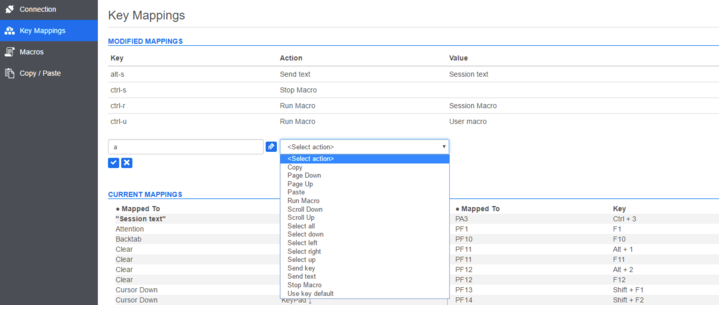Map Keys
You can create keyboard shortcuts that perform any assignable action during a session. The Key Mappings settings page provides a view of the default keyboard map for each host type and the mapped custom keys for that session.
When you create a keyboard shortcut to perform actions, like or , you can specify the necessary parameters in the Value field.
You can map the right and left modifier keys to individual actions. However when they are combined with other keys, there is no differentiation between the right and left keys. For example, Left-Alt can be mapped to Action-A while Right-Alt is mapped to Action-B, but Left-Alt + H will be stored as Alt+H and both Left-Alt+H and Right-Alt+H will be associated with a single mapped action.
HINT:Browsers use keyboard shortcuts to save both time and mouse clicks. When mapping keystrokes it is important to keep this in mind. For example, Ctrl+F1 opens Internet Explorer help as well as the UTS control page. Handy Keyboard Shortcuts gives a brief overview of the keyboard shortcuts used by different browsers.
Different key stroke combinations are also used for copy/paste operations. For example, on a VT host screen, initiates a Select All action. See Copying and Pasting for a list of copy/paste key actions.
-
From the toolbar, click .
-
From the left navigation pane, open the panel.
-
Under , click to enter a new key map entry.
-
Press the key or key combination you want to trigger the assigned action in the key field.
-
From the drop down list, select the action you want to associate with the key selection. If you select , enter the string you want sent to the host in the field. Likewise, if you select , choose the macro you want triggered by the keyboard shortcut.

The Send text action supports mapping characters with codes less than or equal to 0xFFFF via Unicode escape sequences. The escape sequence begins with \u followed by exactly four hexadecimal digits. You can embed Unicode escape sequences in any string. For example, this embedded \u0045 will be interpreted as this embedded E, since 45 is the hexadecimal code for the character E.
To pass Unicode escape sequences to the host, escape the sequence with a leading backslash. For example, to send the string literal \u001C to the host, map a key to \\u001C. Reflection ZFE will convert this to the string \u001C when that key is pressed and send the 6 characters of the resulting string to the host.
HINT:If you are using escape sequences on a VT host, the VT escape sequences begin with either the Unicode value of the escape character, \u001B or the CSI character \u009B. For example, to map the F1 key to Send<ESC>[M you'd enter \u001B[[M. The two brackets are necessary.
-
Click the blue check mark to accept the mapping and add the key map to the session.
To remove existing entries from the table, hover over the line containing the entry you want to delete and click the blue X that displays on the right side.
-
Click to close the Key Mapping panel and resume configuring your host connection.
After you complete mapping keys for the session, the updated Current Mappings table displays the custom key mappings in boldface type. Click the column header to sort the list by Key or Mapped to action.